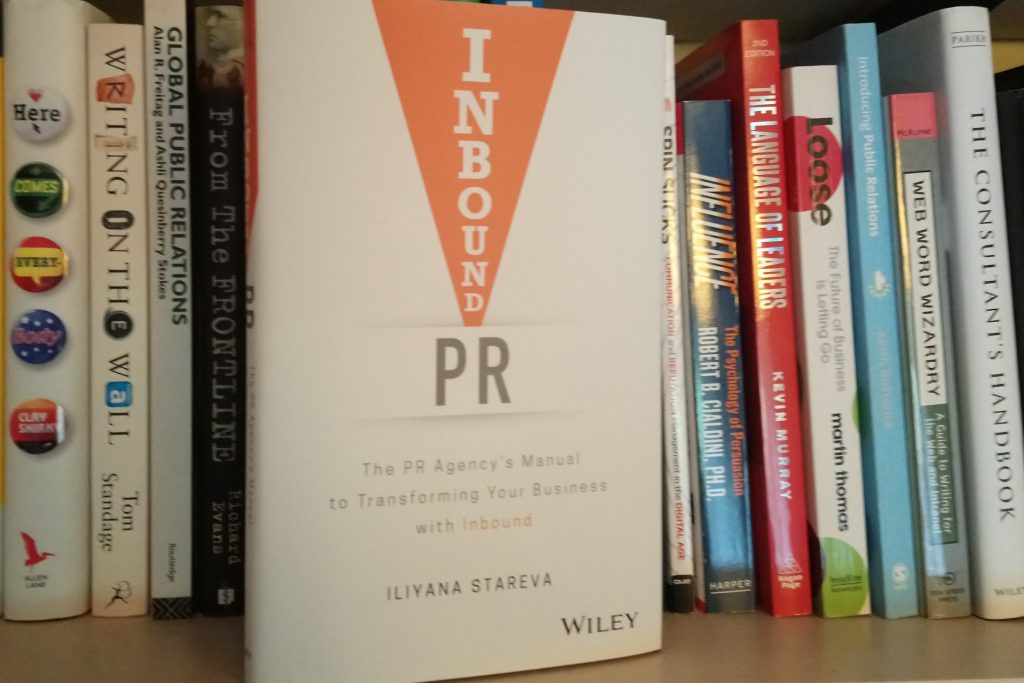Review: Inbound PR

About the author
Richard Bailey Hon FCIPR is editor of PR Academy's PR Place Insights. He teaches and assesses undergraduate, postgraduate and professional students.

Inbound PR: The PR Agency’s Manual to Transforming Your Business with Inbound
Iliyana Stareva
2018, Wiley
‘Inbound PR is about educating people and helping them make decisions.’
First, the premise behind this new book.
Separate industries, with distinct skills and approaches, are on a collision course. Each has its blind spot.
‘Marketers, advisers, and digital professionals struggle with content creation, but they are good at numbers, data and measurement – something PR professionals are still at odds with… PR professionals are the best content creators. They are natural storytellers – this is how it has been since the first press release… On the other hand, PR people are very bad at measurement.’
The answer is what the author describes as inbound PR, ‘where content meets measurement and helps PR people show the real return on investment (ROI) of their efforts in the new digital era.’
She argues that in the digital age there’s more to public relations than media relations. ‘PR can now engage directly with customers, prospects, investors, and any stakeholder group using online channels.’
The premise behind the inbound concept is that as consumers we gather our own information about products and services online. ‘Essentially, we make decisions based on the content that we find when we need it.’ Advertising is an interruption, but ‘we like to be engaged, enticed, and drawn into something interesting.’
In other words, marketers should stop pushing advertising at consumers (the outbound approach) and entice them with interesting content. ‘In essence, inbound is about getting found.’ Public relations has a key part to play around creating and sharing interesting content.
But public relations has been hampered by poor metrics. The author gives a clear summary of the patchy progress from the bad old days of advertising value equivalency (AVE) and the present promise of AMEC’s integrated evaluation framework.
What her focus ignores is that not all public relations serves a marketing purpose. This book assumes that public relations efforts are directed towards attracting qualified leads. Yet sales is not the only outcome of public relations efforts. What about reputation? What about relationships? What about behaviour change? These should also be measured, but it’s harder to do so – and often pointless to attempt to calculate a financial return on investment (ROI).
The section on understanding stakeholder personas and defining the stakeholder journey is original and especially useful. This leads to the content plan: ‘the only way to create content that is going to convert is to start with the persona, then to define the key questions the persona is asking at each of the stages of the journey.’ Next, you need to promote your content. ‘Even with the best SEO machine, you still need to heavily promote your content to drive traffic and engage with your stakeholders.’
Though framed as a sales funnel, it could be applied to attitude or behaviour change campaigns.
Why this focus on sales and marketing? The author works for HubSpot which offers customer relationship management (CRM) software and services.
She’s aware that she’s writing for agencies, but argues that this approach is relevant to internal comms too. The common thread is that all communication, and all relationships, should be focused on the other party. But her advice to agencies is not to experiment on clients; they should first practise what they preach and focus on their own content and storytelling.
The story behind this book is inspiring. I first became aware of Iliyana Stareva when she was studying for a business degree in the UK, and devoted her dissertation to public relations. She has since become a well-known public relations blogger, has gained experience in several European countries and now works for HubSpot in Dublin.
She’d been blogging and giving talks about inbound PR, and Stephen Waddington encouraged her to publish a book. She approached Wiley and the result is this publication. How’s that for can do?
Alongside one from Stephen Waddington, there’s a foreword by David Meerman Scott, author of The New Rules of Marketing and PR.
‘Inbound PR is about building relationships. This doesn’t happen overnight. It takes time, energy, effort, and consistency.’
It’s hard to dispute this argument. But is it new? The distinction between push and pull was already clear in the mid 1990s. Similar points have been made by a succession of authors from Seth Godin’s Permission Marketing (1999) onwards. In this book, he described the distinction between permission marketing and interruption marketing.
Meanwhile, Mark Schaefer has argued more recently (in The Content Code, 2015) that we’ve reached a high water mark for content production. The challenge now is not to produce more content, but to ‘ignite’ what’s out there. Stareva offers some useful advice on repurposing and promoting existing content.
She might describe it as an ‘inbound marketing methodology’ (or even ‘inbound philosophy’), but it’s a well understood approach that has been talked about for two decades.
Of course, pockets of bad practice remain. Some juniors are still tasked with lists of media contacts to call (an example of outbound PR), and they don’t have the experience or the confidence to challenge their bosses.
Some are chasing mentions in the media and ignoring other influencers. Yet ‘there’s no better sales pitch than other people’s recommendations.’
She argues that rather than sending spammy messages to journalists, you should ‘position yourself as an expert and thought leader, so the media will seek out your opinion and come to you, rather than you having to pitch to them all the time.’
Much of the book is advice for agencies on how they should specialise, differentiate themselves, win business and charge higher fees. For teams still chasing media mentions for their clients, measuring cuttings and calling it evaluation, wondering why life is getting harder and unsure of the future – this book will be a useful guide.